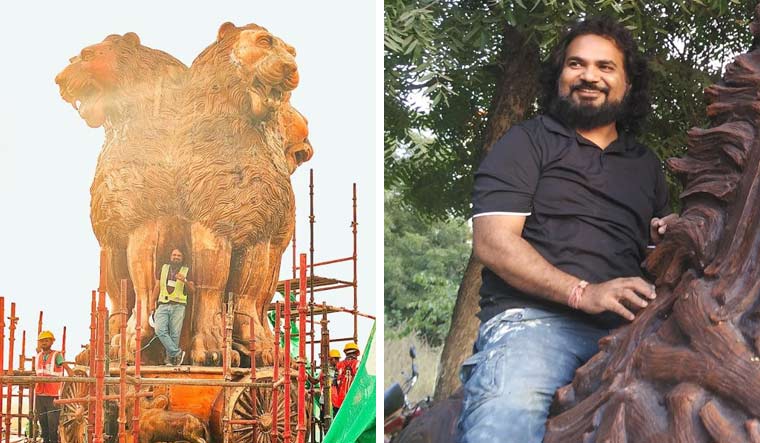Around a year back, when sculptor Sunil Deore began work on the gigantic replica of the national emblem that crowns the new Parliament building, he had little inkling about the uproar it would generate. After the 21-foot bronze representation was unveiled in July, he was flooded with messages on social media. Around 95 per cent of the feedback, he said, was positive; only 5 per cent was critical.
“There were more than a lakh messages on social media, and while there was tremendous appreciation, there was also a view that there was deviation from the original,” said Deore, who is based in Aurangabad. “I believe that the criticism is misplaced, since the model I made was true to the original. I had studied it carefully.” Deore added that one needs to appreciate that this is the largest representation of the national emblem, and on the day of the inauguration, it was viewed from below, with the angle and scale making the lions appear different from the original. “News photographers zoomed in from below to capture the emblem,” he said. “Photos were taken using wide angle. That may have contributed in making the lions look more aggressive.”
Deore collaborated with Jaipur-based sculptor Laxman Vyas, an expert in metal casting, to make the 9,500kg sculpture. The casting was carried out at a foundry in Jaipur under Vyas’s supervision.
Also read
- Historic move: Parliament session to shift to new building from today; members gather for photo op
- 'Inauguration was an opportunity for disqualified to see new Parl building'; Anurag Thakur mocks Rahul Gandhi
- New Parliament building reflects aspirations of new India: PM Modi
- Parliament: Congress calls PM Modi 'self-glorifying authoritarian', RJD's 'coffin' remark draws ire
- Parliament opening: Ceremony begins with puja, PM installs 'Sengol' inside LS chamber
- PM Modi to open India's new Parliament today; ceremony begins with puja, rituals
The 49-year-old Deore is a gold medallist from J.J. School of Arts, with a body of work that includes replicas of the Ajanta and Ellora caves. After he was approached by Tata Projects last year to design a replica of the Sarnath lion capital, he began with sketches and then a clay model at his studio in Aurangabad. The project, Deore said, was undertaken in close coordination with representatives of Tata Projects, and architects and experts from the central public works department.
The sculpture was completed in nine months, which Deore said was extraordinary considering the challenges involved. As the capacity of the foundry was far less than the total weight of the sculpture, the casting was done in parts. “There were around 80 different parts,” he said. “Each part was cast separately and then put together. The parts were lifted with the help of a crane.”
He said that usually a project of this size would have easily taken two years to complete. But, a team of 50 people worked day and night, in two shifts, to ensure that the sculpture was ready in nine months.
Deore is now working on a statue of Shivaji which will be installed in Mumbai. He said it will be the biggest ever statue of the Maratha warrior astride a horse and will be completed in 2023.


